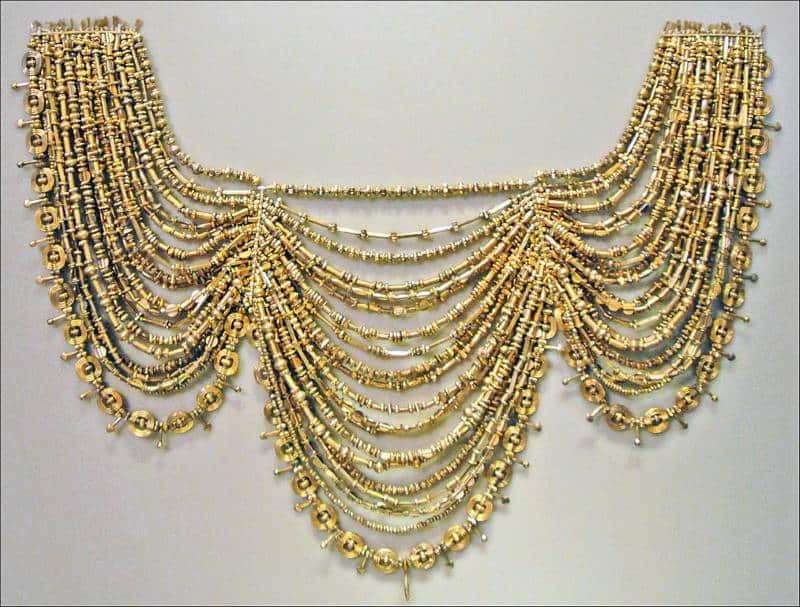

Heinrich Schliemann‘s excavations of Troy are surrounded in controversy for a variety of reasons. One of the controversies is centred on Priam’s Treasure. This is a particular hoard of precious ancient artifacts that Schliemann claimed to have found, which he smuggled back to Europe. He claimed this these artifacts were the treasure of King Priam of Troy. What is the truth about this treasure, and where is it today?
The expression ‘Priam’s Treasure’ refers to a hoard of numerous ancient artifacts that come from the archaeological site of Hisarlik, where Troy once stood. It is composed of thousands of individual items, most of which are small objects such as beads.
The treasure also includes numerous blades of various sorts, such as copper daggers, silver blades, axes, and so forth. Various items of gold were also found, as well as a copper shield.
One of the most outstanding items in Priam’s Treasure is a gold headdress. Schliemann’s second wife, Sophia, is most famous today for having her photo taken while wearing this headdress.
Sophia Schliemann, wife of Homer-obsessed excavator Heinrich, c 1874,wearing the so-called “Jewels of Helen” from “Priam’s Treasure”(both named by self-promoting Heinrich). Found in “Troy Level II”, Hisalrik, these were 1000 yrs earlier than the time described in Homer’s Iliad pic.twitter.com/kthAGyyXA3— Angela O’Brien (@GrecianGirly) April 30, 2023
Historians today do not view Schliemann’s own testimony as particularly reliable. He is known to have been careless and driven as much by fantasy as by fact, and some of his claims are now known to have been outright lies. Nevertheless, many of his claims were genuine, meaning that each one really needs to be evaluated on its own terms.
According to Schliemann’s own testimony, he found Priam’s Treasure on May 31, 1873 during the excavations that lasted from 1871 to 1873. He wrote the following:
“In excavating this wall further and directly by the side of the palace of King Priam, I came upon a large copper article of the most remarkable form, which attracted my attention all the more as I thought I saw gold behind it.”
This is Schliemann’s claim account of how he found this remarkable treasure. However, some scholars today believe that Priam’s Treasure is actually composed of items that were found during the excavation at various different locations across the three-year period. Whether this is really the case or not is impossible to know.
Schliemann was very anxious to get Priam’s Treasure out of the country undetected. It was not a case of him just forgetting or neglecting to inform the local authorities of his findings. According to his own testimony:
“In order to withdraw the treasure from the greed of my workmen, and to save it for archaeology . . . I immediately had [lunch break] called . . . While the men were eating and resting, I cut out the treasure with a large knife.”
Schliemann very deliberately took this treasure and hid it. He claimed that he sent it to a property of John Calvert, the man who had pointed out Hisarlik as the likely location of Troy to Schliemann in the first place. Later, he acquired three horses and used them to transport six chests and one bag full of the treasure. He then had this shipped to Athens, with strict instructions for the containers not to be opened.
Some years later, Schliemann gave part of the treasure to the Ottomans in return for permission to continue excavating Troy. In 1881, the main part of the treasure was acquired by the Royal Museums of Berlin.
The treasure remained there for several decades until 1945, when the Red Army took possession of it during the Battle of Berlin and handed it over to the Soviet Art Committee. After that, aside from the fact that it was taken to Moscow, its location remained a mystery for decades. During the Cold War, the Soviet government denied any knowledge of the fate of Priam’s Treasure. Finally, in 1994, it was revealed to be in the possession of the Pushkin Museum in Moscow. It remains there to this day.
Schliemann was famously mistaken in his understanding of which archaeological level at Hisarlik corresponded to the Troy of Homer’s Iliad. He dug much further down than the Troy of Greek legend.
The layer which he interpreted as the city of King Priam is known as Troy II and is now understood by archaeologists to be dated earlier than 2000 BCE.
This is many centuries earlier than the time of the Trojan War. Its traditional date is c. 1200 BCE. True, there is debate about when exactly the historical events behind the Iliad occurred. Nevertheless, there is no serious scholar who believes that King Priam of Troy lived as long ago as 2000 BCE. Most revisions tend to bring it forward, not push it further back.
Based on these facts, it is clear that Priam’s Treasure was not, in fact, the treasure of King Priam of Troy. Nevertheless, it is a beautiful collection of valuable Bronze Age items.
